This is an Altissa Altix-nb 35mm camera made between 1958 and 1960 by VEB Altissa Camera Werk in Dresden, East Germany. The Altix-nb was the final model in a line of scale focus solid bodied cameras that began with the Altix I in 1939. The Altix-nb had an uncoupled selenium exposure meter and an interchangeable lens mount. The lens mount was unique to the Altix series and although only a few lenses were ever made for it, the ones that exist were all high quality German lenses like the Zeiss Tessar on this sample. The Altix series were all well built cameras, typical of German cameras of the era, and sold well through their life span.
Film Type: 135 (35mm)
Lens: 50mm f/2.8 Carl Zeiss Jena Tessar coated 4-elements
Mount: Altix Breech Lock Bayonet Mount
Focus: 2 feet to Infinity
Viewfinder: Scale Focus Viewfinder
Shutter: Tempor Leaf
Speeds: B, 1 – 1/250 seconds
Exposure Meter: Uncoupled Selenium Cell
Battery: None
Flash Mount: Coldshoe PC Flash Sync
Manual (similar model in German): http://www.cameramanuals.org/pdf_files/altix_n-german.pdf
History
 The history of the company that made this Altissa Altix camera goes back to a company called Photo Spezialhaus, which was founded in 1892 by a man named Richard Knoll in Leipzig, Germany. There is very little information online about what this company did for it’s first couple decades of existence. Almost every resource online recites the same story over, and over, and over, und wieder.
The history of the company that made this Altissa Altix camera goes back to a company called Photo Spezialhaus, which was founded in 1892 by a man named Richard Knoll in Leipzig, Germany. There is very little information online about what this company did for it’s first couple decades of existence. Almost every resource online recites the same story over, and over, and over, und wieder.
These same articles say that the company repaired and manufactured camera supplies. What did they repair, and for whom? And what kinds of things did they make? Who knows!
The important facts are that in 1910, the company relocated to Dresden, Germany, and then in March 1926, the company was taken over by a man named Emil Hofert who apparently already worked for the company. The very next year, the company name changed, possibly to “Fabrik photogr. Artikel Emil Hofert vorm. Ing. Richard Knoll” or “Photographische Manufaktur Richard Knoll”. Regardless of what it was called, it was around this time that “the company” started making simple box cameras.

In March 1931, the company name was changed once again, this time to “Emil Hofert Kamera-Fabrik GmbH” or “Eho Kamera-Fabrik” for short, with “Eho” being a condensed version of the name Emil Hofert.
Eho produced a large number of different box cameras, some sold under the “Eho” name, but many also sold under various names for third party retailers and distributors. It is almost impossible to determine a full list of products the company made at this time as there were so many, and good documentation was not kept (at least not that I could find).
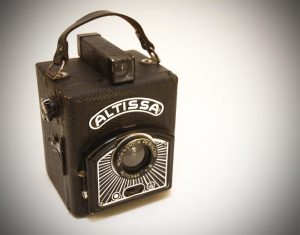
The first appearance of the name “Altissa” was around 1934 with the release of the Altissa Box No. 200. It was a compact all metal box camera with a straight through viewfinder unlike the reflex finders on most box cameras, and it shot 6cm x 6cm images on 120 film. It had a Rodenstock Altissar Periskop f/8 lens and a single shutter speed. The Altissa 200 proved to be very popular and launched several variants, including one that shot 6cm x 4.5cm images. Around 1938 it was renamed the Altissa Model A, but remained mostly unchanged.
In late 1934, there was some sort of upheaval of management within the company, possibly due to Emil Hofert falling ill. His long time partner, Berthold Altmann became managing director of the company, and in January 1935, became the owner. Emil Hofert would pass away in July 1936 at the age of 66. In May 1936, Eho would move to a new location in Dresden and grew to more than 60 employees.

Possibly due to new leadership, the company set it’s sights on more advanced cameras than just simple box cameras, and several new designs were put into development including a Twin Lens Reflex called the Altiflex in 1937, and a compact 35mm camera called the Altix. Even the simple Altissa box camera saw the release of a Super-Altissa model that came with a more advanced f/3.5 Altissar lens, and more advanced Prontor and Compur shutters.
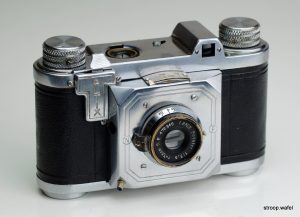
The original Altix (later referred to as the Altix I) was a simple, but strange 35mm scale focus camera. It shot square 24mm x 24mm images, like the Bolta Photavit and Zeiss-Ikon Tenax. It had an f/3.5 triplet lens and a 3-speed shutter. Later versions had a front lens mount that could be easily screwed out to allow for close-up focus shots. Although I could not find any kinds of production numbers, the Altix had to have had some level of success as it became one of the company’s most successful cameras, launching an entire Altix line that would last nearly 20 years.
Like most German optics companies, World War II caused a lot of turmoil for the company. It seems that between 1940 and 1941, Eho would change it’s name two different times, once to “AMCA Camera Werk Berthold Altmann”, and then again to “Altissa Camera Werk Berthold Altmann”. I couldn’t find any information about what AMCA/Altissa did during the war, but it’s most likely the factory was used to produce items for the German war effort. In February 1945, during heavy bombing by Allied fighters, the Dresden factory was completely destroyed, leaving nothing left.
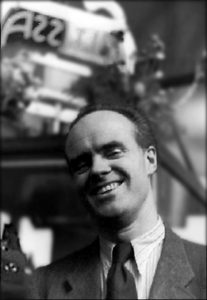
In May 1946, Berthold Altmann would attempt to resurrect his company by teaming up with a man named Fritz von Dosky who owned a company called ALDO-Feingeräte-Bau GmbH which produced microscopes for the medical field. I am not sure if Berthold Altmann continued to use the name Altissa Camera Werk or a new name as there is very little information about the company during this period. I have to assume they were still called Altissa as I have found nothing to contradict that.
Progress was slow as the entire company had to be rebuilt from the ground up, including securing a new factory, equipment, and hiring employees. A year later in 1947, camera production would resume with a revised version of the original Altix with a new front plate and shutter assembly. This new camera would become known as the Altix II. Production of box cameras would also resume, including an all new Altissa-Box.
Dresden is located in what would become Soviet controlled East Germany after the war. As a result, all companies became state operated entities. The Soviet Union was a communist country who believed that all citizens and all companies worked for the benefit of the people. While Altissa was able to continue making cameras, they likely had to obey certain restrictions and demands from the East German government.
This proved to be a problem for Berthold Altmann, who in late 1950 would flee East Germany to West Germany, abandoning his company. He was tried and found guilty of crimes under the Economic Penal Decree of 1948 and all of his assets, including Altissa were seized by the government and put under the jurisdiction of VVB Optik Jena. The abbreviation ‘VVB’ stands for ‘Vereinigung Volkseigener Betriebe’, or ‘Association of Local Companies’ in English. It was a form of middle management that oversaw the operation of small companies in East Germany. The company would later be renamed VEB Altissa Camera Werk, a name it would keep until 1959.
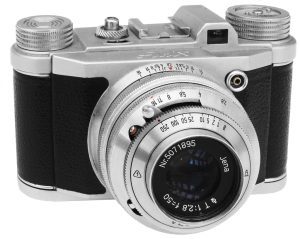
Despite this tumultuous time with the ownership of Altissa, the company did well. The 35mm Altix and Altissa box cameras sold well. The Altix would continue to be refined, with the Altix III and IV released in 1950 and 1952 respectively, improving the ergonomics, shutter, and lenses of the camera. A variant of the Altix III called the Altix IIIA would abandon the original 24mm x 24mm frame size and switched to the international standard of 24mm x 36mm.
The Altix IV would become Altissa’s best selling camera up until this point, staying in continuous production until 1959. It would be the first Altissa exported to western countries where it was sold there as the Classic 35. Later versions of the Altix IV would be assembled in the former Yugoslavia by ZRAK Sarajevo.
In 1954, the Altix IV would be upgraded to have an interchangeable lens mount and would be called the Altix V. The Altix V’s mount was a proprietary breech lock mount that was unique to Altix cameras. Several high quality German lenses were available for the Altix designed by Zeiss and Meyer-Optik, which helped elevate the reputation of the Altix cameras to a much higher level than the earlier variants.
Finally, in 1957, the Altix would see it’s first major redesign, in a new model called the Altix-n. Featuring a squared off body with a flat top plate, the Altix-n had a much larger and brighter viewfinder, a lever wind, and a removable back for easier film loading compared to the bottom loading design of all previous models. The Altix-n used the same breech lock mount as the Altix V and was compatible with the same lenses.
There would also be an Altix-nb with an uncoupled selenium light meter, which is the model being reviewed here. There are two variants of the Altix-nb with the exposure meter in different locations, both sold with the same name. The earlier versions had a top mounted meter that increased the overall height of the camera to accommodate the meter. Starting sometime in 1958, the Altix-nb’s meter moved to within the top plate of the camera making the top plate of the camera completely flat. At this same time, both the Altix-n and Altix-nb would receive another upgrade to the viewfinder adding projected frame lines for 50 and 90mm lenses.
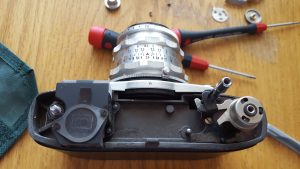
It would appear that a possible rangefinder variant of the Altix was in development around the time of the Altix-nb as some examples have a provision under the top plate for a rangefinder window and mirror. There are reports that a few test models were produced and at least one is in a private collection, but I have never seen it.
VEB Altissa Camera Werk would continue to make several different Altix and Altissa cameras until 1959 when the company would be merged into VEB Kinowerke Dresden which was a conglomerate of several Dresden camera companies including Pentacon, Zeiss-Ikon, Reflekta, and several others. All other Altissa cameras would be discontinued except for the Altix-n and nb models. These final two cameras would be produced at least until 1960, perhaps even 1961. You can easily identify a VEB Kinowerke Dresden Altix by the presence of the Ernemann tower logo embossed into the leatherette on the film door. After the final Altix models stopped production, the history of Altissa and all the various different versions of the company that preceded it would come to an end.
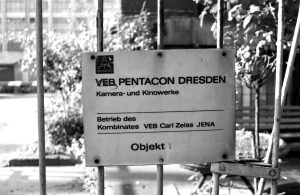
VEB Kinowerke Dresden would continue to absorb many other Dresden area camera companies including Belca, Welta, Meyer-Optik, Certo, Ihagee, and several others. In 1964, the company was renamed VEB Pentacon Dresden, a name it would mostly keep until the 1980s. During this time, the company concentrated mostly on screw mount SLRs. It would limp on until the fall of the Soviet Union and would fold with it’s assets liquidated at auction in 1991. After it’s liquidation, several of Pentacon’s trademarks and properties were purchased by a man named Heinrich Mandermann who would start a company called Pentacon GmbH, but this was an entirely new company that had no chronology with the companies that preceded it.
I have written about camera companies with confusing histories before, but this one was one of the most difficult. The majority of what I’ve typed above has come from German language sites that I used Google Translate to understand. On more than one occasion, I found conflicting info about some of the dates or names listed above. I tried to use my best judgement to try and compile a chronological order, but I fully acknowledge that I may have gotten some facts wrong. If anyone reading this has more accurate info regarding the history of the Altissa company, please let me know by using the Contact option at the top of my site.

I do enjoy diving into these complex histories of these companies, and I found it especially interesting that so many websites refer to the company that made these cameras as “Eho-Altissa” although it doesn’t appear that any time in the company’s history was it officially known by that name. “Eho” is simply a shortened version of Emil Hofert who owned the company prior to the war, and “Altissa” was the name after that. Eho-Altissa is nothing more than a nickname given to a single company known by multiple names throughout it’s existence. It would be sort of like referring to modern day Nikon cameras as being made by “Nikon Kogaku” or Sony cameras as “Konica-Minolta-Sony”, maybe “Konoltny” for short!
Today, the entire Altix series are quite collectible, although here in the United States aren’t very common. The few times one shows up for sale, it’s usually the European Altix models, rather than the export Classic 35. As I write this, a quick search for “Altix” on the US version of eBay returned a grand total of 3 results in the United States, and another 105 overseas. Searching for the Classic 35 model is nearly impossible due to the generic sounding name.
If you are located in Europe where these cameras were more common, finding one for a good price is probably not that difficult, but for people in the US like myself, your best option for finding a nice Altix is to buy internationally.
My Thoughts
The first time I ever saw an Altix, it was a model IV and I loved the look of the body, the curves around the edges of the lens mount, the stepped top plate and the beautiful lens. Most Altixes have a Trioplan lens, but many also have a Zeiss Tessar, both excellent lenses.
As I learned more about the Altix however, I began to learn of it’s quirks. The interesting film compartment, the interlink between the shutter release and the cocking lever on the shutter, and then the very tiny viewfinder. While not the tiniest ever, for a camera made in the middle of the 1950s, this was pretty small. I wear prescription glasses and find these small viewfinders to be very difficult to use. I’ve even scratched a pair of lenses once by making contact with the back of a Kiev 4, so it’s not something I look forward to using.
One day while reading CJ’s Classic Cameras, I learned of the later Altix-n model with a significantly redesigned body and much larger viewfinder. Ooh, I thought! I should get one of these.
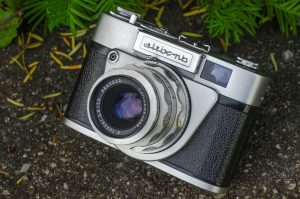
But wait, there’s more! Then there was the last variant of the Altix-nb that had not only a brightline viewfinder, but also an even LARGER viewfinder. I was in Altix heaven! I knew that yes, this was the model I must have. It would take some time before I found one in my usual budget, but I finally located one and waited patiently for it to arrive.
Upon it’s arrival, I was pleased to see that the camera was in mostly excellent condition. The meter was dead, and there was an ever so slight hint of internal haze somewhere inside the Tessar lens, but nothing that should dramatically affect images. The shutter fired at all speeds with an authoritative snap, the viewfinder was clear, but sadly, the projected frame lines were extremely dim. I found it a bit peculiar that the viewfinder could be so bright and clear, but the frame lines were almost invisible. Perhaps some previous owner of the camera had opened it up, and in an attempt to clean it, accidentally wiped off the lines or something. Oh well, I should be able to still use the camera. I took it outside to practice with the camera, and HOLY COW!
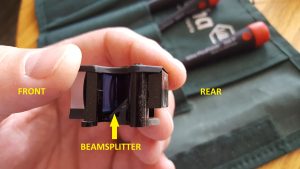
As it turns out, the Altix-nb is unique in that the projected frame lines get their light from the top of the camera, and not the front like how pretty much every other camera works. The reason I couldn’t see the lines earlier was because I was playing with it indoors, and there wasn’t enough light above me to make the lines visible, but as soon as I stepped outside and the bright sunny sky was shining down on the camera, the lines appeared bright as ever. I went from what I thought was going to be almost unusable frame lines, to the brightest frame lines I’ve ever seen on a camera!
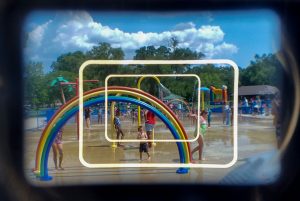
In the image to the left, the frame lines look like they’re off center, but that is just a side effect of how I captured the image with a cell phone. In reality, both sets of frame lines are perfectly centered in the viewfinder. The reason for the two sets of lines is that the later Altix cameras have an interchangeable lens mount and the frame lines represent different focal lengths. The smaller window is for a 90mm telephoto lens, the larger window represents 50mm for the various 50mm lenses available, and the overall whole visible window (without frame lines) represents 35mm for one of two wide angle lenses that were made.
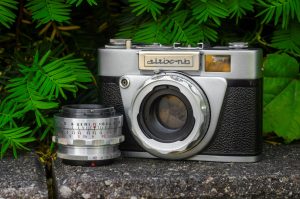
The Altix’s lens mount uses a breech lock bayonet style system similar to Canon’s FD mount where the lens is mounted via lining up two red dots and then a collar around the mount is rotated to lock the lens in place. On a breech lock system, the lens does not rotate, the collar does.
In total, there were only 6 lenses made for the Altix mount, they are:
- Carl Zeiss Jena Tessar 50mm f/2.8
- Meyer-Optik Trioplan 50mm f/2.9
- E. Ludwig Meritar 50mm f/2.9
- Meyer-Optik Primagon 35mm f/4.5
- Meyer-Optik Telefogar 90mm f/3.5
- Meyer-Optik Lydith 30mm f/3.5 (extremely rare)
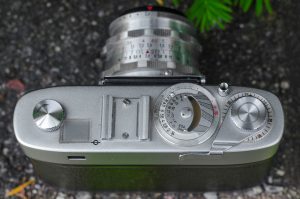
The top plate of the camera is a bit cluttered with the smallish rewind knob on the left, immediately next to the light window that illuminates the viewfinder’s frame lines. Then there’s the accessory shoe and the largish exposure meter. The meter was dead on my camera so I couldn’t test it, but even if it was working, it appears that some cost cutting was done here because all of the markings are either painted or silk-screened on and most had faded away.
Next to the meter is the dual wind lever / exposure counter. The wind lever wraps around to the back of the camera like many cameras of the period did. It is neither better or worse than typical wind levers that stay on the top of the camera, just different. Finally, getting lost in between the exposure meter and wind lever, is the tiny shutter release which is threaded for a cable.
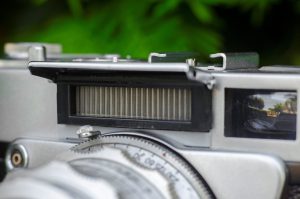
On the front of the camera is the selenium cell exposure meter. Normally covered by a metal door that is adorned with the name of the camera, the door has 5 tiny holes in it allowing a little bit of light to shine through, giving the exposure meter a type of “Hi / Lo” system where you can take a reading with the door closed in extremely bright situations, but in darker situations, the door flips up allowing a full reading of available light in lower light or indoor shooting situations.
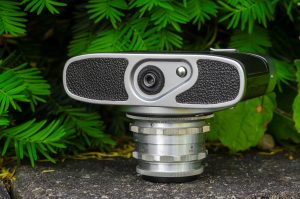
Loading film into the camera is a bit interesting, at least compared to most other cameras of the day. Where Altix models prior to the Altix-n were true bottom loaders like the Leica M3, the Altix-n and -nb models have a removable back revealing a film compartment with a hinged pressure plate that folds away. To open the camera, you must loosen the knurled black ring on the bottom of the camera around the tripod mount. This ring is permanently attached to the bottom of the camera and when completely loosened, will not fall off.
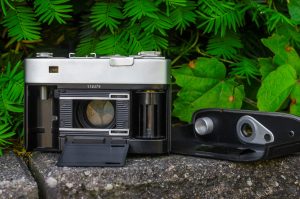
After removing the back of the camera, you see what looks to be a pretty modern (for the day) 35mm camera. Film loads from left to right, and the fixed takeup spool rotates counterclockwise when winding. Why did Altissa insist on using the foldaway pressure plate rather than attach it to the door itself like most other manufacturers did is anyone’s guess, but for obvious reasons, it is very important to remember to fold it shut over the film BEFORE trying to reattach the door!
Once the film is in the camera and you’ve manually reset the exposure counter, the rest of the shooting experience is quite normal. The shutter release is comfortably located, and I love the arrangement of the three rings around the lens.
The shutter speed is closest to the body of the camera and in a location where it can’t accidentally be changed with the camera to your eye. Even on fully mechanical cameras, I still tend to calculate exposure in a pseudo-aperture priority mode where I set the shutter speed in advance of composing my shots. I tend to shoot a majority of my images outdoors in good lighting, so I will almost always use a Sunny 16 friendly shutter speed and just leave it there unless my lighting significantly changes.
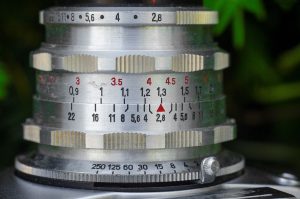
The middle ring is the focus and the one I’m going to change more often than shutter speeds, but since this isn’t an SLR and changing focus doesn’t change the image in the viewfinder, I tend to set this almost immediately before composing my image. Lastly, the outer ring is the aperture scale and the only ring I tend to change with the camera to my eye. The Zeiss Tessar has click stops at each f/stop making counting the stops from wide open very easy to do.
This arrangement of settings around the lens works well for me because from the body to the tip of the lens, they start with the one I’m least likely to change, to the one I’ll change before composing a new image, to the one I’m most likely to change with the camera to my eye.
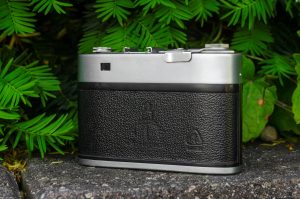
One last comment about the experience of using the Altix-nb is in reference to the shutter itself. The Tempor shutter on the Altix has a very prominent and authoritative SNICK to it each time the shutter closes. While most leaf shutters tend to be quiet, sometimes they can be too quiet and it’s not always obvious when a very quiet shutter has fired, especially when there is a lot of ambient noise. I also don’t want a mechanical PING either, like on the Argus C3. You will never be left guessing if the shutter had fired on this camera.
After shooting my first roll of film through the Altix, I was absolutely impressed. This is a handsome camera that is well designed, and just quirky enough to be interesting, while not frustrating to use either. The control layout is well thought out and doesn’t get in the way while out shooting. I loved the bright viewfinder and found the implementation of the top mounted window for the projected bright lines to be very effective. I cannot think of any other camera with a setup like this. The only question that remained was how did the images turn out. With a Carl Zeiss Jena Tessar lens, I rightfully should have some very high expectations.
My Results
I shot a roll of Fuji 200 film with my Altix-nb in the summer of 2017. About half of the images were generic family shots at a picnic, and the rest were of some abandoned houses around where I live. Upon a last minute inspection of the camera before using it, I did notice a tad bit of internal haze inside of the lens. This type of haze is not uncommon with Zeiss lenses of this period, so I made no attempt to repair it as I had hoped that it wouldn’t show up in the final images.
The images above reflect the most interesting of the bunch. Sharpness and exposure are spot on. The Altix and Zeiss lens are certainly a capable combination and the East German Tempor shutter was only limited in it’s top speed of 1/250.
The haze I had noticed inside of the lens did turn out to increase softness and halos in images where the sky is visible. At first I was a bit disappointed in this result, but decided that this kind of flaw comes with the territory of shooting with an vintage camera. Since the Altix has interchangeable lenses, I could just swap the lens with a different one and improve the situation, or I could try a known contrasty black and white film for my next roll to offset the haze.
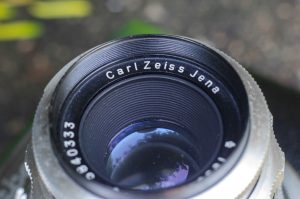
Whatever I end up doing, I can wholeheartedly say that this one conditional issue did not tarnish my impression of the camera. The Altissa Altix-nb is an outstanding camera both in design and technical prowess. I can see why so many of them were sold as this was likely a very popular camera in East Germany and beyond back in the 50s and 60s. Despite this being a later variant when there was a lot of uncertainty in the East German camera market, the quality of the camera still seems quite high.
If I’m being nitpicky, I would say that I prefer the earlier Altix-n’s cleaner design, but I loved the top mounted light window for the very bright frame lines. The layout of the controls around the lens was excellent and I loved the sound the shutter made. I think Altix unnecessarily complicated the film loading design and by the time this model was being released, they could have simplified it a bit.
Overall, I am extremely pleased this camera is in my collection and apart from the haze issue with the lens, I could see this being a model I use regularly. I would love to experience one of the earlier models one day, but do not have any regrets at having this model.
My Final WordHow these ratings work |
The Altissa Altix-nb is the last variant in the Altix family and offers the most modern features. It has a simplified (but still odd) film loading sequence, an interchangeable lens mount, a large and bright viewfinder with some of the brightest projected frame lines I have ever seen in a camera, well laid out controls, and an excellent build quality. Although my particular example was hampered by a bit of haze in the lens, I cannot fault a 60+ year old camera for a condition issue like this. I loved shooting the Altix and was very happy with the images it made. I absolutely recommend adding one of these to your collection if you have the opportunity. | ||||||
| Images | Handling | Features | Viewfinder | Feel & Beauty | History | Age | |
| 2 | 1 | 1 | 2 | 2 | 0 | 30% | |
| Bonus | none | ||||||
| Final Score | 10.4 | ||||||
Additional Resources
http://www.cjs-classic-cameras.co.uk/altix/altix2.html
http://camera-wiki.org/wiki/Altix
http://web.archive.org/web/20090707021507/http://www.altissa-museum.de/kameras/altix/altixnb/index.html (in German)
http://www.altissa.de/seiten/geschichte.htm (in German)
http://www.dresdner-kameras.de/altix/altix.html (in German)
http://www.collection-appareils.fr/x/html/page_standard.php?id_appareil=10804 (in French)

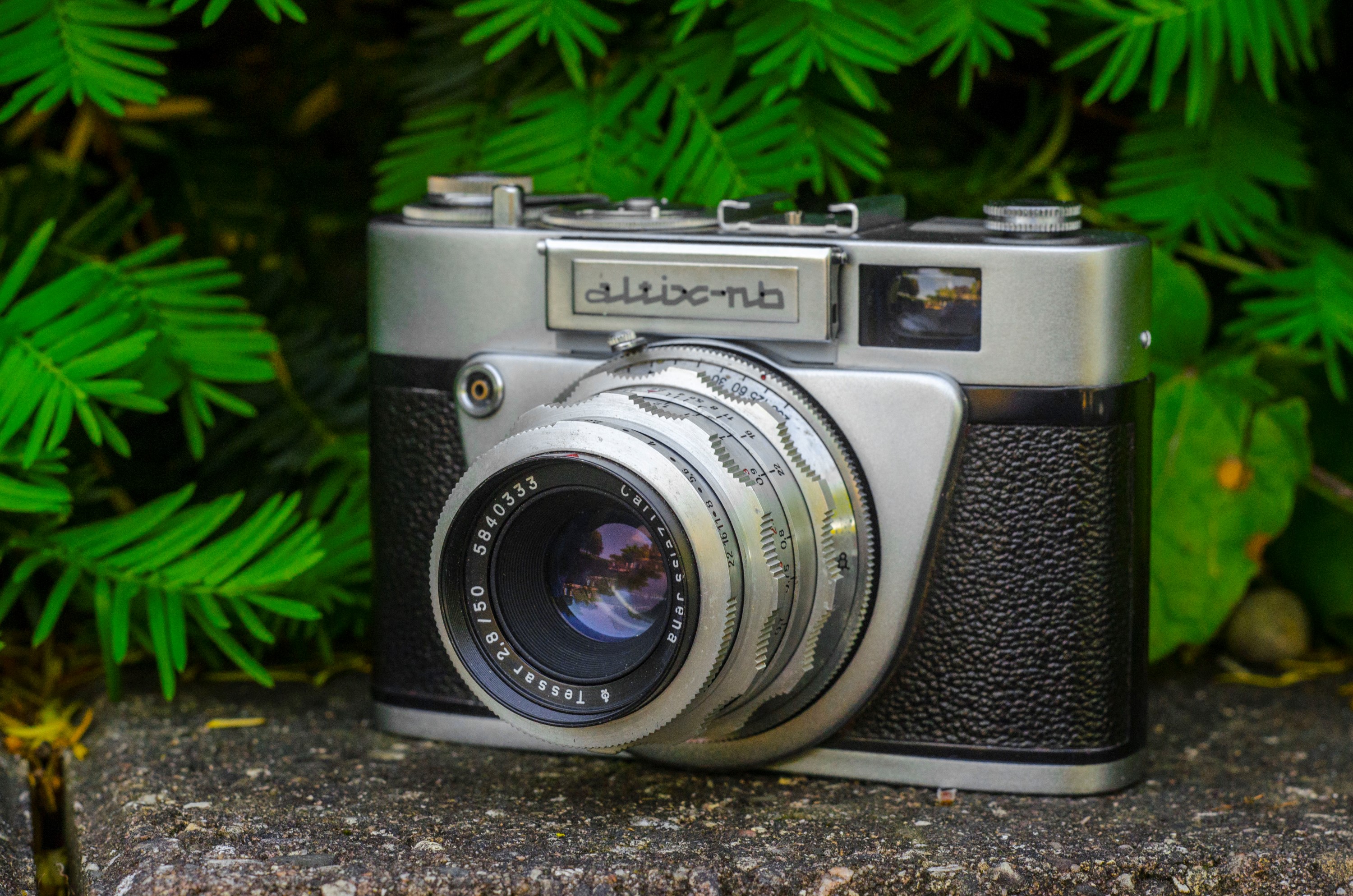
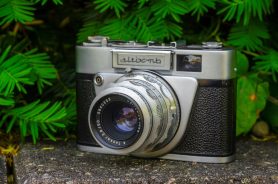
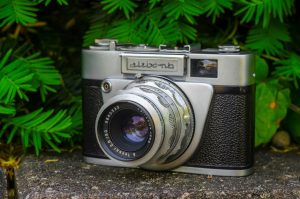








Been amateur photographer for the best part of 60 years. Went digital in 2004 only. Available adapters have transformed vintage lenses. No money, no time, no desire to go back to dark-room work and so on. Understand fully people who want to COLLECT old gear. I possess dozens and dozens of lenses dating 1930 ==> end of 20ieth century and use them ALL, but on modern cameras. Not ONE is a bad lens. Huge pleasure. People “despise” Meyer’s Domiplan, yet it is a great lens. And “idols” (Ultron, Quinon, Trioplan 100…) are all very good indeed, but are the pictures taken with them so much more interesting? Fact is, lenses made for Altix (by CZJ or by MOG) are of very good technical level. I use the Tessar, the Trioplan 50, the Telefogar and expect a Primagon. I like the passion YOU convey.
Thanks for the feedback Charlier! I agree with you in that every vintage lens is worth shooting. I generally enjoy the “lesser” lenses like the Domiplan, Radionar, and various other three and four element lenses made by other lens makers as they often add character and a distinct look that the Planars, Septons, and Xenons don’t.
Hi! Nice to read. I bought one almost one year ago in a package of other cameras and lenses and its not before now I’ m gonna try it out. Its an N – version 2. Let you know later how it turns out. It is with a Tessar 50mm f2.8 that looks great. No haze, no fungus, no scratches.